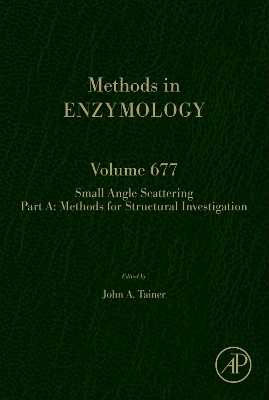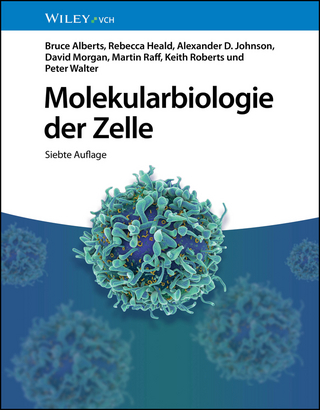
Small Angle Scattering Part A: Methods for Structural Investigation
Academic Press Inc (Verlag)
978-0-323-99179-7 (ISBN)
Additional sections in the book cover SEC-SAXS-MALS data acquisition and processing pipeline at SIBYLS, SEC-SAXS: pros and cons, experimental set-up, examples and software developments, Radiation damage and sample economy for stopped-flow methods in the time regime of millisecond and above, Stopped-flow-time-resolved SAXS, Insights on Temp-jump, time-resolved SAXS, and much more.
Prof. John A. Tainer trained in X-ray crystallography, biochemistry, and computation. With this foundation, he contributed to structural biochemistry for the biology for DNA repair, reactive oxygen control, the immune response, and other stress responses for >20 years. His NCI-funded papers report robust structural and biophysical measurements to advance understanding of cellular stress responses that are evolutionarily conserved and important in preserving genome stability and preventing diseases in humans. His methods, results, and concepts have stood the test of time: they are often used and cited >30,000 total times. At Scripps, Prof. Tainer created and ran the Scripps NSF Computational Center for Macromolecular Structure along with an NIH P01 on Metalloprotein Structure and Design. He also helped develop and utilize the Scripps share of the NSF San Diego Supercomputer Center. At LBL, he developed and directed the ~$2.9 million/year DOE Program “Molecular Assemblies Genes and Genomics Integrated Efficiently (MAGGIE) from 2004-2011. At Berkeley, Prof. Tainer designed, developed, and directed the world’s only dual endstation synchrotron beamline SIBYLS (Structurally Integrated BiologY for Life Sciences), used by >200 NIH labs. This unique technology integrates high flux small angle x-ray scattering (SAXS) and macromolecular X-ray crystallography (MX). At SIBYLS his lab develop, optimize, and apply technologies to determine accurate structures, conformations and assemblies both in solution and at high resolution. His lab defined an R-factor gap in MX revealing an untapped potential for insights on nanoscale structures by better modeling of bound solvent and flexible regions. At the University of Texas MD Anderson Cancer Center, Prof. Tainer is joining biochemistry and biophysics to fluorescent imaging measures of protein and RNA interactions on DNA for mechanistic insights. He is integrating these data with cryo-EM, MX and SAXS structures by linking MD Anderson and SIBYLS facilities. As an originator of applying proteins from thermophiles to defining dynamic structures and functional conformations, Prof. Tainer develop methods for measurements on structures including conformations, and assemblies in solution. Prof. Tainer has combined cryo-EM and X-ray structures with biochemistry to define functional assemblies. His lab introduced new equations for analyzing X-ray scattering for flexible macromolecules and complexes. His lab also defined a novel SAXS invariant: the first discovered since the Porod invariant ~60 years ago. The defined parameters quantitatively assess flexibility, measure intermolecular distances, determine data to model agreement, and reduce false positives. Prof. Tainer has a track record of successful collaborations, completing projects, sharing innovating approaches and technologies, developing insights along with new structural data, and providing fundamentally important technologies that improve the ways others do their research. He has benefited from continuous peer-reviewed NCI funding since 1999. NCI support has allowed Prof. Tainer to develop expertise in the methods development and in the structural biology of DNA repair, immune responses, and other stress.
1. SAXS foundations and metrics Robert Rambo 2. Contrast variation sample preparation protocols, experimental procedures, and rudimentary analysis Lois Pollack 3. Molecular deuteration for neutron scattering Anthony Patrick Duff 4. Planning, Executing and Assessing the Feasibility of SANS Contrast Variation Experiments Susan Krueger 5. Technical considerations for small-angle neutron scattering from biological macromolecules Cy Jeffries and Andrew Whitten 6. Advanced sample environments and capabilities at our synchrotron X-ray beamline with example applications Melissa Graewert and Dmitri Svergun 7. SEC-SAXS-MALS data acquisition and processing pipeline at SIBYLS Daniel Rosenberg and Michal Hammel 8. SEC-SAXS: pros and cons, experimental set-up, examples and software developments Patrice Vachette, Javier Perez and Aurelien Thureau 9. Radiation damage and sample economy for stopped-flow methods in the time regime of millisecond and above Michael Weiss 10. Stopped-flow-time-resolved SAXS Henning Tidow and Inokentijs Josts 11. Insights on Temp-jump, time-resolved SAXS Philip Anfinrud 12. Time-resolved Small-Angle Neutron Scattering (TR-SANS) for structural biology of dynamic systems: history, recent developments, and practical guidelines Frank Gabel 13. SAXS data collection for Protein Fibrillation Bente Vestergaard and Annette Langkilde 14. Actin assembly Kristina Djinovic Carugo 15. SAS induced disulfide bond damage Edward Snell 16. High pressure SAXS Richard Gillilan 17. Challenges and opportunities in soft X-ray scattering of biological molecules Esther W. Gomez 18. Collection of scattering data from lipid membranes and nanodiscs Lin Yang 19. SANS stealth methods for membrane proteins Henning Tidow and Inokentijs Josts 20. Predicting solution scattering patterns with explicit-solvent molecular simulations Jochen S. Hub 21. From dilute to concentrated solutions of intrinsically disordered proteins: Sample preparation and data collection Marie Skepo 22. Extracting physically-relevant ensemble properties of disordered proteins and other polymers from SAXS data Joshua A. Riback 23. Determining topological structures of RNA using SAXS Yun Xing Wang 24. SAS data analyses of polydisperse systems with special emphasis on transient complexes Pau Bernado and Aamin Sagar 25. FEL samples and data collection Peter Zwart
| Erscheinungsdatum | 25.11.2022 |
|---|---|
| Reihe/Serie | Methods in Enzymology |
| Verlagsort | Oxford |
| Sprache | englisch |
| Maße | 152 x 229 mm |
| Gewicht | 450 g |
| Themenwelt | Naturwissenschaften ► Biologie ► Biochemie |
| Naturwissenschaften ► Biologie ► Genetik / Molekularbiologie | |
| ISBN-10 | 0-323-99179-3 / 0323991793 |
| ISBN-13 | 978-0-323-99179-7 / 9780323991797 |
| Zustand | Neuware |
| Haben Sie eine Frage zum Produkt? |
aus dem Bereich


